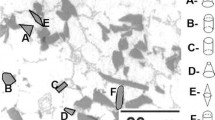Abstract
A numerical approach is presented in this paper for the calculation of the elasto-plastic deformation behavior of particulate reinforced composites. The effect of shape and arrangement of particulate on the elastic modulus and tensile deformation behavior were estimated. The approach presented can consider the shape and arrangement effect of reinforcement particulate via a simple parameter called the geometrical factor (Gf). Elastic moduli and tensile deformation estimations for the particulate reinforced composites were studied. The results of proposed approach were in very good agreement with the results of finite element analysis.






Similar content being viewed by others
Abbreviations
- RVE::
-
Representative Volume Element
- FEM::
-
Finite Elements Method
- PAA::
-
Projection Area Approach
- MTM::
-
Mori Tanka Method
- H-S::
-
Hashin Shtrikman bounds
References
Ibrahim IA et al. (1991) Particulate reinforced metal matrix composites—a review. J Mater Sci 26:1137–1149
Ceniga L (2012) A novel analytical model and energy analysis of thermal stresses in two-phase composites. Meccanica 47:845–855
Yilmaz S, Aran A (1998) Finite element analysis of deformation behavior in ductile matrix containing hard particles. Mater Sci Technol 14:1154–1162
Li S, Wongsto A (2004) Unit cells for micromechanical analyses of particle-reinforced composites. Mech Mater 36:543–572
Mura T (1998) Micromechanics of defect in solids. Kluwer, The Netherlands
Hashin Z, Shtrikman S (1967) A variational approach to the theory of the elastic behavior of multiphase materials. J Mech Phys Solids 11:127–137
Voight W (1928) Lehrbuch der Kristallphysik. Teubner, Berlin-Leipzig
Reuss A (1929) Berechung der fliessgrenzen von mischkristallen aurf grund der plastiizitatsbedingug fur Eeinkristalle. Z Angew Math Mech 9:49–58
Mori T, Tanaka K (1973) Average stress in the matrix and average elastic energy of materials with misfitting inclusions. Acta Metall Mater 21:571–574
Eshelby CC (1957) The determination of the elastic field of an ellipsoidal inclusion, and related field. Proc R Soc Lond A 241:376–396
Weng GJ (1984) Some elastic properties of reinforced solids with special reference to isotropic ones containing spherical inclusions. Int J Eng Sci 22:845–856
Segurado J, Llorca J (2002) A numerical approximation to the elastic properties of sphere reinforced heterogeneous. J Mech Phys Solids 50:2107–2121
Gambin W, Barlat F (1997) Modeling of deformation texture development based on rate independent crystal plasticity. Int J Plast 13(1/2):7–85
Yilmaz S (2009) An approach for predicting the elastic modulus of heterogeneous materials. Mater Des 30:2938–2945
Kalidindi SR, Franco E (1997) Numerical evaluation of isostrain and weighted-average models for elastic moduli of three-dimensional composites. Compos Sci Technol 57:293–305
Chinh PD (2002) Bounds on the elastic moduli of completely random two-dimensional polycrystals. Meccanica 37:503–514
Castaneda PP (2012) J Mech Phys Solids 60:1583–1604
Ahuja N, Schachter BJ (1983) Pattern models. Wiley, New York
Balac I et al. (2004) Estimation of elastic properties of a particulate polymer composite using a face cantered cubic FE model. Mater Lett 58:2437–2441
Castaneda PP, Suquet P (1998) Nonlinear composites. Adv Appl Mech 34:171–302
Acknowledgements
The author acknowledges financial support from the BAP Program of Technical University of Istanbul.
Author information
Authors and Affiliations
Corresponding author
Rights and permissions
About this article
Cite this article
Yilmaz, S. An approach for prediction of the elasto-plastic behavior of particulate reinforced composites. Meccanica 48, 2271–2279 (2013). https://doi.org/10.1007/s11012-013-9744-5
Received:
Accepted:
Published:
Issue Date:
DOI: https://doi.org/10.1007/s11012-013-9744-5




